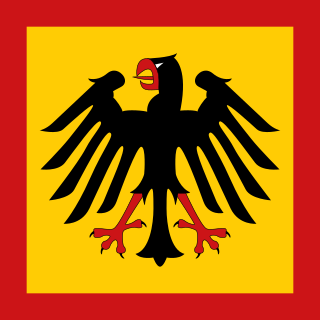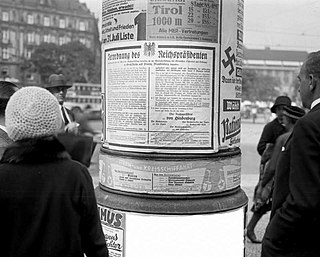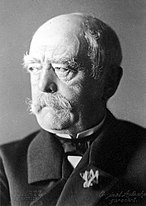
German Unity Day is the National Day of Germany, celebrated on 3 October as a public holiday. It commemorates German reunification in 1990 when the German Democratic Republic joined the Federal Republic of Germany, so that for the first time since 1945 there existed a single German state. German Unity Day on 3 October has been the German National Holiday since 1990, when the reunification was formally completed.

The Weimar Republic, officially known as the German Reich, was a historical period of Germany from 9 November 1918 to 23 March 1933, during which it was a constitutional federal republic for the first time in history; hence it is also referred to, and unofficially proclaimed itself, as the German Republic. The period's informal name is derived from the city of Weimar, which hosted the constituent assembly that established its government. In English, the republic was usually simply called "Germany", with "Weimar Republic" not commonly used until the 1930s.

The president of Germany, officially titled the Federal President of the Federal Republic of Germany, is the head of state of Germany.

The national flag of Germany is a tricolour consisting of three equal horizontal bands displaying the national colours of Germany: black, red, and gold. The flag was first sighted in 1848 in the German Confederation. The flag was also used by the German Empire from 1848 to 1849. It was officially adopted as the national flag of the German Reich from 1919 to 1933, and has been in use since its reintroduction in Federal Republic of Germany in 1949.

The vice-chancellor of Germany, unofficially the vice-chancellor of the Federal Republic of Germany, officially the deputy to the federal chancellor, is the second highest ranking German cabinet member. The chancellor is the head of government and, according to the constitution, gives this title of deputy to one of the federal ministers. It is common that the title is given to the major minister provided by the (smaller) coalition partner.

Reichswehr was the official name of the German armed forces during the Weimar Republic and the first years of the Third Reich. After Germany was defeated in World War I, the Imperial German Army was dissolved in order to be reshaped into a peacetime army. From it a provisional Reichswehr was formed in March 1919. Under the terms of the Treaty of Versailles, the rebuilt German Army was subject to severe limitations in size, structure and armament. The official formation of the Reichswehr took place on 1 January 1921 after the limitations had been met. The German armed forces kept the name Reichswehr until Adolf Hitler's 1935 proclamation of the "restoration of military sovereignty", at which point it became part of the new Wehrmacht.

The Constitution of the German Reich, usually known as the Weimar Constitution, was the constitution that governed Germany during the Weimar Republic era (1919–1933). The constitution declared Germany to be a democratic parliamentary republic with a legislature elected under proportional representation. Universal suffrage was established, with a minimum voting age of 20. The constitution technically remained in effect throughout the Nazi era from 1933 to 1945 as well as during the Allied occupation of Germany from 1945 to 1949, though practically it had been repealed by the Enabling Act of 1933 and thus its various provisions and protections went unenforced for the duration of Nazi rule, and after World War II, the power of the Allied Control Council and four occupying powers once again stood above the provisions of the constitution.

Otto Braun was a politician of the Social Democratic Party of Germany (SPD) during the Weimar Republic. From 1920 to 1932, with only two brief interruptions, Braun was Minister President of the Free State of Prussia. The continuity of personnel in high office resulted in a largely stable government in Prussia, in contrast to the sometimes turbulent politics of the Reich. During his term of office, Prussia's public administration was reorganized along democratic lines. He replaced many monarchist officials with supporters of the Weimar Republic, strengthened and democratized the Prussian police, and made attempts to fight the rise of the Nazi Party.

The President of the Reich was the German head of state under the Weimar constitution, which was officially in force from 1919 to 1945. In English he was usually simply referred to as the President of Germany.

The coat of arms of Germany displays a black eagle with a red beak, a red tongue and red feet on a golden field, which is blazoned: Or, an eagle displayed sable beaked langued and membered gules. This is the Bundesadler, formerly known as Reichsadler. It is one of the oldest coats of arms in the world, and today the oldest national symbol used in Europe.
Article 48 of the constitution of the Weimar Republic of Germany (1919–1933) allowed the Reich president, under certain circumstances, to take emergency measures without the prior consent of the Reichstag. This power came to be understood to include the promulgation of emergency decrees. It was used frequently by Reich President Friedrich Ebert of the Social Democratic Party to deal with both political unrest and economic emergencies. Later, under President Paul von Hindenburg and the presidential cabinets, Article 48 was called on more and more often to bypass a politically fractured parliament and to rule without its consent. After the Nazi Party's rise to power in the early 1930s, the law allowed Chancellor Adolf Hitler, with decrees issued by Hindenburg, to create a totalitarian dictatorship by seemingly legal means.

The 1932 Prussian coup d'état or Preußenschlag took place on 20 July 1932, when Reich President Paul von Hindenburg, at the request of Franz von Papen, then Reich Chancellor of Germany, replaced the legal government of the Free State of Prussia with von Papen as Reich Commissioner. A second decree the same day transferred executive power in Prussia to the Reich Minister of the Armed Forces Kurt von Schleicher and restricted fundamental rights.

Otto Lebrecht Eduard Daniel Meissner was head of the Office of the President of Germany from 1920 to 1945 during nearly the entire period of the Weimar Republic under Friedrich Ebert and Paul von Hindenburg and, finally, under the Nazi government under Adolf Hitler.

The Federal Ministry of Defence, abbreviated BMVg, is a top-level federal agency, headed by the Federal Minister of Defence as a member of the Cabinet of Germany. The ministry is headquartered at the Hardthöhe district in Bonn and has a second office in the Bendlerblock building in Berlin, which is occasionally used as a metonym to denote the entire Ministry.

The Free State of Prussia was one of the constituent states of Germany from 1918 to 1947. The successor to the Kingdom of Prussia after the defeat of the German Empire in World War I, it continued to be the dominant state in Germany during the Weimar Republic, as it had been during the empire, even though most of Germany's post-war territorial losses in Europe had come from its lands. It was home to the federal capital Berlin and had 62% of Germany's territory and 61% of its population. Prussia changed from the authoritarian state it had been in the past and became a parliamentary democracy under its 1920 constitution. During the Weimar period it was governed almost entirely by pro-democratic parties and proved more politically stable than the Republic itself. With only brief interruptions, the Social Democratic Party (SPD) provided the Minister President. Its Ministers of the Interior, also from the SPD, pushed republican reform of the administration and police, with the result that Prussia was considered a bulwark of democracy within the Weimar Republic.

The chancellor of Germany, officially the federal chancellor of the Federal Republic of Germany, is the head of the federal government of Germany, and the commander-in-chief of the German Armed Forces during wartime. The chancellor is the chief executive of the Federal Cabinet and heads the executive branch. The chancellor is elected by the Bundestag on the proposal of the federal president and without debate.

The Papen cabinet, headed by the independent Franz von Papen, was the nineteenth government of the Weimar Republic. It took office on 1 June 1932 when it replaced the second Brüning cabinet, which had resigned the same day after it lost the confidence of President Paul von Hindenburg.
The Provisional Law and Second Law on the Coordination of the States with the Reich were two laws enacted by the German government of Adolf Hitler to expand its control over the seventeen German states (länder). The Provisional (First) Law dissolved all the sitting landtage, except for that of Prussia, and reconstituted them in accordance with the results of the recent parliamentary election of 5 March 1933, which had given the Nazi Party and its coalition partner, the German National People's Party (DNVP), a majority of the Reichstag seats. The Second Law established the new powerful position of Reichsstatthalter appointed by the central government to effectively take control of each state administration. The effect of these laws was to undermine the power and influence of all political parties other than the Nazis and the DNVP, and to move Germany significantly away from being a federal republic and put it on a path to becoming a unitary state.
A Reichsverweser or imperial regent represented a monarch when there was a vacancy in the throne, such as during a prolonged absence or in the period between the monarch's death and the accession of a successor. The term Verweser comes from the Old High German firwesan and means "for or in the place of a person". The plural form is the same as the singular.























































